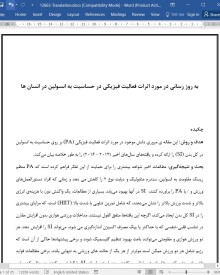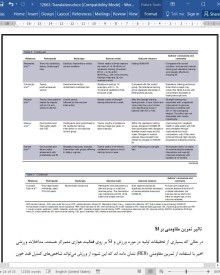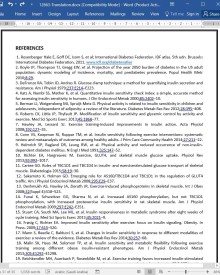
دانلود مقاله به روز رسانی در مورد اثرات فعالیت فیزیکی در حساسیت به انسولین در انسان ها
چکیده
هدف و روش: این مقاله ی مروری دانش موجود در مورد اثرات فعالیت فیزیکی(PA) بر روی حساسیت به انسولین در کل بدن (SI) را ارائه کرده و یافتههای سالهای اخیر (۲۰۱۳ - ۲۰۱۶) را به طور خلاصه بیان میکند.
بحث و نتیجهگیری: مطالعات اخیر شواهد بیشتری را برای حمایت از این تفکر فراهم کرده است که PA منظم ریسک مقاومت به انسولین، سندرم متابولیک و دیابت نوع ۲ را کاهش می دهد و زمانی که افراد دستورالعملهای ورزش و / یا PA را براورده کنند، SI در آنها بهبود مییابد. بسیاری از مطالعات، یک واکنش دوز، با هزینهی انرژی بالاتر و شدت ورزش بالاتر را نشان میدهند، که شامل تمرین تناوبی با شدت بالا (HIIT)است، که مزایای بیشتری را در SI کل بدن ایجاد میکند، اگرچه این یافتهها متفق القول نیستند. مداخلات ورزشی هوازی بدون افزایش مقارن در تناسب قلبی-تنفسی که با حداکثر یا پیک مصرف اکسیژن اندازهگیری می شود، میتواند SI را افزایش دهد. هر دو ورزش هوازی و مقاومتی میتوانند باعث بهبود تنظیم گلیسمیک شوند و برخی پیشنهادها حاکی از آن است که رژیم شامل هر دو ورزش ممکن است موثرتر از هر یک از حالت های ورزشی به تنهایی باشد. برخی مطالعات فواید ناشی از ورزش، که مستقل از رژیم غذایی و کاهش وزن است، را برای SI را گزارش میکنند، در حالی که برخی دیگر همبستگی با کاهش چربی را نشان میدهند در نتیجه بحث در مورد اهمیت نسبی PA و کاهش وزن ادامه دارد. در طول تمرین، انقباض عضلانی بهبودهایی در سیستم SI را تحریک می کند که همراه با افزایش فعالیت AMPK است، که TCB1D1 را غیر فعال کرده، انتقال GLUT4 به غشا سلولی و در نتیجه افزایش جذب گلوکز را ارتقاء می دهد. بعد از ورزش، افزایش Akt ,TCB1D1 را غیرفعال میکند و در نتیجه انتقال GLUT4 به غشا سلولی را افزایش میدهد. کاهش اسیدهای چرب اشباعشده درون ماهیچه و کاهش پیوسته در سرامیدها، اما نه دی اسیل گلیسرول، یک ارتباط بالقوه بین محتوای لیپید و SI فراهم میکند. افزایش کپیلاری شدن ماهیچه اسکلتی یک سازگاری مستقل دیگر را فراهم میکند که از طریق آن SI بهبود می یابد، همانطور که فعالیت سلول بتا را افزایش میدهد. مطالعات اخیر، به منظور بررسی پتانسیل افزایش بهبود ناشی از ورزش در SI و کنترل گلیسمی، مداخلات ورزشی را با رژیم غذایی و دستکاری در تغذیه ترکیب کرده اند.
نتیجه گیری
مطالعات اخیری (منتشر شده در سال های ۲۰۱۳ - ۲۰۱۶) که شامل PA هستند، یافتههای تحقیقات قبل مبنی بر کارآیی آن در بهبود SI را تائید می کنند. یک شیوه زندگی شامل ورزش هوازی و / یا PA مطابق با دستورالعمل ها مبنی بر شدت متوسط برای حداقل ۳۰ دقیقه، ۳ - ۵ روز در هفته است، با بهبود SI و کنترل قند خون همراه است. بهبود حاد در SI ( در ۲ - ۷۲ ساعت بعد از ورزش) بعد از یک جلسه فعالیت ورزشی اتفاق می افتد و از مطالعات ورزشی مشخص است که سازگاریهای مزمن، شامل مداخلات ورزشی برای حداقل ۸ هفته است. مزایای عمومی PA/ ورزش در تمام سنین از کودکان تا بزرگسالان مسنتر، از جمله آنهایی که به عنوان افراد بدون علامت / سالم، پیش دیابتی / MetS، و بیماران مبتلا به T2Dm طبقهبندی میشوند، مشهود است. با این حال، یافتهها بدون ابهام نیستند و حتی در مطالعات تمامی شاخصهای حساسیت به انسولین و کنترل قند خون بهبود نیافتهاند. در واقع، حتی با افزایش بیان IRS - ۱ و GLUT4، کاهش در IR تضمین نمیشود. پاسخ به دوز گاهی آشکار است، و جلسات تمرین با شدتهای بالاتر از جمله hiit و SIT میتوانند مزایای بیشتری برای SI ایجاد کنند، اما همیشه اینگونه نیست. در واقع این سوال باقی میماند که آیا حجمهای بیشتر از تمرین با شدت متوسط یا حجمهای پایینتر از ورزش با شدت بالاتر ممکن است مقیاس متفاوتی از سازگاری ایجاد کنند و ایا می توانند این کار را از طریق تحریک سازگاریهای متفاوت انجام دهند. محققان همچنین در حال ارزیابی این موضوع هستند که آیا جلسات حجم پایینتر ممکن است مزایای عملی با سازگاری بیشتر، از طریق افزایش لذت و تعهد زمان کمتر داشته باشند، زیرا فقدان زمان یک دلیل رایج برای عدم پیروی از توصیههای ورزشی است.
ABSTRACT
Purpose and methods: This review presents established knowledge on the effects of physical activity (PA) on whole-body insulin sensitivity (SI) and summarises the findings of recent (2013–2016) studies.
Discussion and conclusions: Recent studies provide further evidence to support the notion that regular PA reduces the risk of insulin resistance, metabolic syndrome and type 2 diabetes, and SI improves when individuals comply with exercise and/or PA guidelines. Many studies indicate a dose response, with higher energy expenditures and higher exercise intensities, including high intensity interval training (HIIT), producing greater benefits on whole-body SI, although these findings are not unanimous. Aerobic exercise interventions can improve SI without an associated increase in cardiorespiratory fitness as measured by maximal or peak oxygen consumption. Both aerobic and resistance exercise can induce improvements in glycaemic regulation, with some suggestions that exercise regimens including both may be more efficacious than either exercise mode alone. Some studies report exercise-induced benefits to SI that are independent of habitual diet and weight loss, while others indicate an association with fat reduction, hence the debate over the relative importance of PA and weight loss continues. During exercise, muscle contraction stimulated improvements in SI are associated with increases in AMPK activity, which deactivates TCB1D1, promoting GLUT4 translocation to the cell membrane and thereby increasing glucose uptake. Postexercise, increases in Akt deactivate TCB1D4 and thereby increase GLUT4 translocation to the cell membrane. The reduction in intramuscular saturated fatty acids and concomitant reductions in ceramides, but not diacylglycerols, provide a potential link between intramuscular lipid content and SI. Increased skeletal muscle capillarisation provides another independent adaptation through which SI is improved, as does enhanced b cell activity. Recent studies are combining exercise interventions with dietary and feeding manipulations to investigate the potential for augmenting the exercise-induced improvements in SI and glycaemic control.
CONCLUSION
Recently (published 2013-2016) studies involving PA confirm previous research findings of its efficacy in improving SI. A lifestyle incorporating aerobic exercise and/or PA that complies with the guidelines of being of moderate intensity for at least 30 min on 3–5 days per week, is associated with improved SI and glycaemic control. Acute improvements in SI (2–72 hours postexercise) occur after a single bout of exercise and chronic adaptations are evident from training studies involving interventions undertaken for at least 8 weeks. The benefits of PA/exercise are evident across all ages from children to older adults, including those categorised as asymptomatic/healthy, prediabetic/MetS, and patients with T2DM. However, the findings are not unequivocal and even within studies not all indicators of insulin sensitivity and glycaemic control display improvements. Indeed, even with increases in the expression of IRS-1 and GLUT4, decreases in IR are not guaranteed.69 A dose response is sometimes evident, and exercise sessions using higher intensities, including HIIT and SIT can produce greater benefits to SI, but not always. Indeed there remains the question of whether larger volumes of moderate intensity exercise or lower volumes of higher intensity may produce a different magnitude of adaptation, and could do so via stimulating different adaptations. Researchers are also assessing whether lower volume sessions may have the practical advantages of greater compliance, through increased enjoyment and a lesser time commitment, since lack of time is a commonly given reason for noncompliance with exercise recommendations.
چکیده
مقدمه
روش ها
مکانیسمهای مولکولی برای تغییرات ناشی از ورزش در SI و کنترل گلیسمی
چاقی، قابلیت دسترسی به چربی اضافی و SI
دیگر تغییرات مولکولی و فیزیولوژیکی مرتبط با بهبودهای ناشی از ورزش در SI
به روز رسانی ها در مورد واکنشهای حاد SI به ورزش
به روز رسانی ها در مورد مطالعات ارتباط بین SI و سبک زندگی PA
به روز رسانی های حاصل از مطالعات ارزیابی تاثیرات ورزش بر SI
مداخلات ورزشی هوازی، از جمله ارزیابی تاثیر حجم و شدت تمرین
تاثیر تمرین مقاومتی بر SI
تاثیر ورزش در یک حالت تغذیه شده و یا ناشتا و دیگر دستکاری های ورزش-تغذیه
ورزش، SI و تغییرات توده ی بدنی
غیر پاسخ دهنده ها و پاسخ دهنده های معکوس به ورزش
نتیجه گیری
منابع
ABSTRACT
INTRODUCTION
METHODS
Molecular mechanisms for exercise-induced changes in SI and glycaemic control
Obesity, excess lipid availability and SI
Other molecular and physiological changes linked to exercise induced improvements to SI
Updates to acute SI responses to exercise
Updates on the association between SI and PA—lifestyle studies
Updates from studies assessing the effects of exercise training upon SI
Aerobic exercise interventions, including the assessment of the influence of exercise volume and intensity
Effects of resistance training upon SI
The effect of exercising in a fed or fasted state and other exercise-food manipulations
Exercise, SI and changes to body mass
Non-responders and adverse responders to exercise interventions
CONCLUSION
REFERENCES
- اصل مقاله انگلیسی با فرمت ورد (word) با قابلیت ویرایش
- ترجمه فارسی مقاله با فرمت ورد (word) با قابلیت ویرایش، بدون آرم سایت ای ترجمه
- ترجمه فارسی مقاله با فرمت pdf، بدون آرم سایت ای ترجمه



